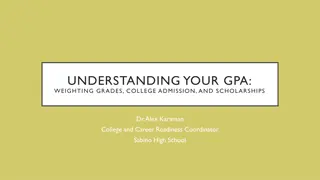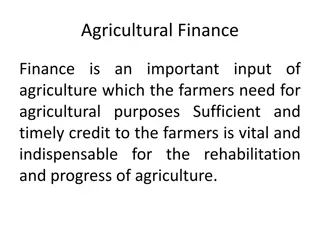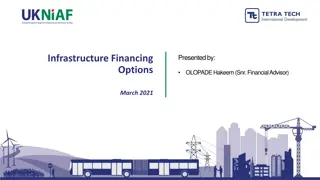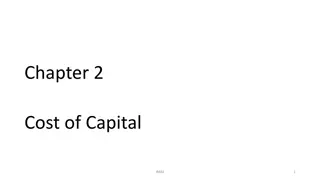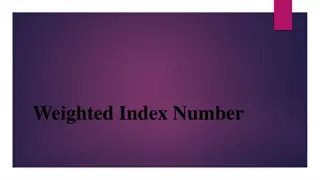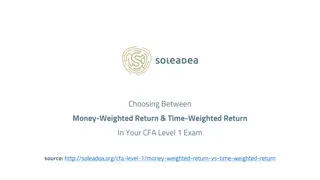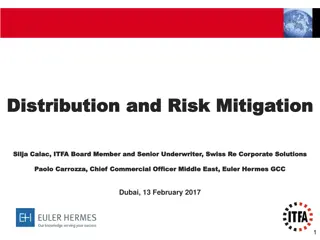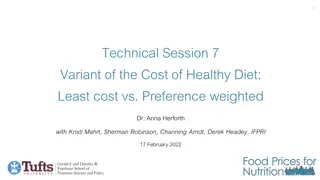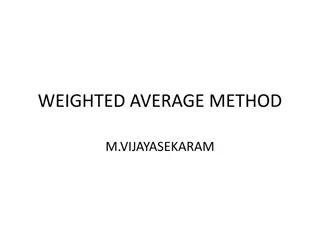Understanding School Finance: Key Funding Sources and Weighted Funding
Explore the differences in funding between charter schools and traditional ISDs, sources of funding in charter school systems, the impact of attendance on budget allocation, challenges in the Texas school finance system, and the future outlook for charter school funding amidst potential changes. Delve into topics such as the State Foundation School Program, federal entitlements, grants, private foundations, and gifts. Gain insights into the unique weighted funding model based on student groups served and programs offered, with focus on special education and bilingual students.
Uploaded on Sep 14, 2024 | 1 Views
Download Presentation

Please find below an Image/Link to download the presentation.
The content on the website is provided AS IS for your information and personal use only. It may not be sold, licensed, or shared on other websites without obtaining consent from the author. Download presentation by click this link. If you encounter any issues during the download, it is possible that the publisher has removed the file from their server.
E N D
Presentation Transcript
SCHOOL FINANCE Bruce Marchand, Ed.D.
Presentation Topics How charter school funding is different than traditional ISDs; Funding sources in charter school systems; How attendance drives budget dollars; Determine why the TX school finance system has been challenged through litigation; Discuss what the future might hold for charter school funding with potential state changes and ESSA. New PSF Bond Guarantees through SB 1480 HB 2610 (Minutes Bill) and the new fix for charter schools (HB 2442) Review current school finance situation after the 85thlegislature What you should be doing now in terms of budget preparation for 2017- 2018 New Instructional Facilities Allotment (NIFA) funding
List the funding sources used in your system s budget
Which funding sources did you list? State Foundation School Program Federal Entitlements Grants Private Foundations and Gifts
Funding Sources (All Schools)
Funding Sources (All Schools) Not all funding sources are available to charter schools
Weighted Funding Funding is determined based on the types of student groups you serve and which programs they participate in at your campus. Charter schools tend to serve a disproportionately high number of: Special Education students Bilingual students
Weighted Funding Foundation School Program funding provides a base amount of funding for each student and an additional weight (percentage of the base amount) depending on the program(s) the student participates in.
Weighted Funding Weights are added because, theoretically, some students are more expensive to educate due to the programs they participate in. Weighted programs include: Special Education Bilingual/ESL Program Career and Technology Gifted and Talented
Weighted Funding Special education students are funded based on their disability and instructional arrangement. Generally, the more restrictive the educational environment, the bigger the weight, with a continuum of weights as follows: Number Enrolled in Speech Therapy (Code 00) Number Enrolled in Mainstream (Code 40) Number Enrolled in Resource Room (Code 41 & 42) Number Enrolled in Self-Contained Mild/Mod/Sev (Code 43 & 44) Number Enrolled in Full-Time Early Childhood (Code 45) Number Enrolled in Homebound (Code 01) Number Enrolled in Hospital Class (Code 02) Number Enrolled in Off-Home Campus (Code 91-98) Number Enrolled in VAC (Code 08) Number Enrolled from State Schools (Code 30) Number Enrolled in Residential Care & Treatment (Code 81-89)
Weighted Funding Bilingual/ESL Students receive weighted funding as well. Schools must follow identification procedures as set forth for Language Proficiency Assessment Committees (LPACs) Career and Technology students receive funding based on the classes they take and if they are in a coherent sequence (two or more related courses) in a CTE program. Students are identified as a 1, 2 or 3 in regards to their CTE courses. A 1 weight is assigned for a single course. A 2 weight is assigned if a student is taking the 2nd course in a sequence. A 3 weight (most revenue) is assigned if a student is in the 3rd course in a sequence or beyond.
Weighted Funding Gifted and Talented students receive additional funding if they are designated GT by the school identification committee using procedures set forth in the Texas State Plan for Gifted and Talented students (2009). Schools receive funding for each identified GT student up to 5% of their total enrollment. Schools can identify additional students beyond 5% of their enrollment, but they won t receive funding for the additional students. High school students, regardless of the program they are in, currently receive an additional $275 per student under the high school allotment.
Group Activity: A look at weighted funding
Weighted Funding Which student would receive the greatest amount of revenue based on the weighted student formula? Rank the students from the least amount of funding to the greatest. 1.A high school special education student in a self-contained class for reading. 2.A Hispanic elementary student 3.A high school student taking their first class in the CTE Marketing sequence. 4.A middle school student in an ESL program taking a CTE forensics class. 5.An elementary student in a mainstream special education setting. 6.An elementary student identified as eligible for ESL services but the parent denies the service.
Weighted Funding 1.A Hispanic elementary student 2.An elementary student identified as eligible for ESL services but the parent denies the service. 3.An elementary student in a mainstream special education setting. 4.A middle school student in an ESL program taking a CTE forensics class. 5.A high school student taking their first class in the CTE Marketing sequence. 6.A high school special education student in a self-contained class for reading.
Attendance Matters Charter school funding is calculated based on student attendance. Your funding will be reduced when students are absent. Schools typically take attendance at 10:00 am
Coding Matters The Public Education Information System (PEIMS) encompasses all data requested and received by TEA about public education, including student performance, personnel, financial, and organizational information.
Data Collected in PEIMS Organizational Budget Actual financial Staff Student demographic Program participation Leaver Attendance Course completion Discipline
Foundation School Program Foundation School Program Tier II Tier I Level II Enrichment Program Block Grants Level III Enrichment Other Allotments
Tier I Calculation Program Grants Calculation Regular Program (Refined ADA - (SpEd FTEs-CTE FTEs)) * State Average Adjusted Allotment Special Education Sum of (Enrollment*Attendance*Weight) * State Average Adjusted Allotment Mainstream Special Ed Mainstream SpEd ADA * State Average Adjusted Allotment * 1.1 Career & Technology Sum of (Enrollment * Attendance * Weight) * State Average Adjusted Allotment * 1.35 Gifted & Talented GT Enrollment * State Average Adjusted Allotment * 0.12 Compensatory Ed Compensatory Ed Enrollment * State Average Adjusted Allotment * 0.2 PRS Enrollment * Attendance * 0.2936 * State Average Adjusted Allotment * 2.41 Pregnancy Related Services Bilingual Education BE Enrollment * Attendance * State Average Adjusted Allotment * 0.1 Other Allotments Calculation Transportation Allotment High School Allotment High School ADA * $275
Foundation School Program Charter School Tier II Calculation Level II Enrichment $74.28 * WADA * State Average District Tax Rate I *100 ($61.85 in 2015) Level III Enrichment $31.95 * WADA * State Average District Tax Rate II * 100 WADA Calculation=(Total Adjusted Tier I * Guaranteed Yield Adjustment)/State Average Basic Allotment) Guaranteed Yield Adjustment=0.9733
Legislative Changes Foundation School Program Increased Basic Allotment 2013- $4,765 2014- $4,950 2015- $5,040 2016- $5,140 2017- $5,140 Restored Regular Program Adjustment Factor 2013- 0.98 2014- 1.00 2015- 1.00 2016 1.00 2017-1.00 Tier II Guaranteed Yield 2014 -$59.97(Level 1) and $31.95 (Level 2) 2015- $61.86(Level 1) and $31.95 (Level 2) 2016-$74.28 (Level 1) and $31.95 (Level 2). 2017-$74.28 (Level 1) and $31.95 (Level 2). Increased ASATR Reduction Factor 2013- 0.9235 2014- 0.9263 2015- 0.9263
Entitlements Entitlements funded in 12 monthly payments from two sources: Available School Fund Set aside from Permanent School Fund and 25% of fuel tax receipts to support public school system 444.148 * previous year WADA Foundation School Program State and federal funds Remainder of entitlement
Group Activity: What federal funds can you use?
Which federal funds can be used for particular programs? Title I, Part A Title IIA IDEA B Perkins Grant Title III REAP CSP Bilingual/ESL students Students in rural areas Econ disadvantaged students Professional development Special education students Used to expand and replicate charter schools Career and technology students
Which federal funds can be used for particular programs? Title I, Part A Title IIA IDEA B Perkins Grant Title III REAP CSP Econ disadvantaged students Professional development Special education students Career and technology students Bilingual/ESL students Students in rural areas Used to expand and replicate charter schools
Estimate of State AidTemplate Download from Charter School Finance webpage of TEA website. The template for the school year is posted annually by July 1. (In general a few days prior to July 1) Requires working knowledge of Student Attendance Accounting Handbook Utilize template to: Prepare for FSP Estimate Report. Reconcile to latest Summary of Finances. Determine or project cash flow/payments. Plan yourbudget. Determine final settle-up for the school year. 2 9
Estimate of State Aid Template Excel workbook with 6 worksheet tabs. 1. Data Elements To prepare submission of FSP Estimate Report. SCE Worksheet To prepare accurate estimate of the highest 6-month average of State Compensatory Education (SCE) enrollment for FSP EstimateReport. StateAid To reconcile to the latest Summary of Finance (SOF). Membership Report Demonstrates membershipcalculation. Payment Calculator To determine payments based on approved six-week district summary attendance reports. FSP ADA Projection Report (NEW) Models the FSP ADA Projection Report interface. 2. 3. 4. 5. 6. 3 0
Estimate of State Aid Template Data Elements For use in entering new enrollment estimates for 1st six-week only in preparation for FSP Estimate Report. To load prior year in column C of State Aid tab, enter charter school s 6-digit county districtnumber. Note: For new charter schools, no prior yeardata. Your updates in the Data Elements tab feeds into column D of the State Aidtab. Data entry validation warnings for exceeded maximum approved enrollmentcap. Any charter reporting data in the FSP Estimate Data Report should complete Estimate of State Aid Template before submitting to TEA. In general, the Data elements tab is used one-time only. However, you may return for the purpose of determining per-student funding estimate information. 3 1
Estimate of State Aid Template Data Elements (partial screen shot) 3 2 Also, remember to complete SCE Worksheet tab to provide accurate estimate in cell B33 for Compensatory EducationEnrollment
Estimate of State Aid Template SCE Worksheet Assists charter schools in arriving at accurate estimate of the highest 6-month average of State Compensatory Education (SCE)enrollment. Enter YES or NO to this question: Is this the Charter School's First Year in Operation? If NO enter October 2016 through September 2017 actual and estimate SCE data. If YES enter an estimate of October 2017 through September 2018 SCEdata. Complete SCE worksheet before entering SCE high six-month average in the Data Elements tab in cell B33 or State Aid tab. Utilizing this worksheet is beneficial because it should minimize adjustments to the State Compensatory Education allotment. Failure to do so may result in over/under reporting for majority of school year (September March). 3 3
Estimate of State Aid Template 10 SCE Worksheet (screenshot)
Estimate of State Aid Template State Aid For use in reconciling to the latest Summary of Finance (SOF) and taking your FSP ADA Projection Report (interface report before Six-week District Summary Attendance is submitted) for modeling the next iteration of the SOF. Multiple columns (A through L) and rows (1 through 96) with the following major column descriptions: Weight or Rate Column B (NEW effective with 2017-2018 estimate of state aid template) Preliminary SOF Column C (loads prior year data after CDN number is entered in Data Elements tab) Foundation School Program (FSP) Estimate (From Data Elements) Column D (based on revised/new data populated in Data Elementstab) FSP ADA Projection Average - Columns E through J Near Final SOF ColumnK Final SOF ColumnL Hover over individual cells for exact location on SOF to assist in completing data entry (Columns E throughL). 3 5
Estimate of State Aid Template 3 6 State Aid (partial screen shots)
Estimate of State Aid Template Payment Calculator Assists charter school determine cash flow and next payment based on approved six-week district summary attendance reports. Enter data in the field according to your Payment Class which is either Payment Class 4 (Regular) or Payment Class 5 (Accelerated). Obtain your Payment Ledger Report and your most recent SOF or Estimate of State Aid template updated with FSP ADA projection data to complete. Allows charter school to also determine Final settle-up payments or adjustment. 3 7
Estimate of State Aid Template 3 8 Payment Calculator (screenshot)
Estimate of State Aid Template FSP ADA Projection Report Models the ADA Projection Report found in the FSP system which calculates the annualized average of Six-Week District Summary Attendance Reports values. In the FPS system, TEA calculates the annualized average using: Approved Six-Week District Summary Attendance Reports, and Projected Six-Week District Summary Attendance Reports for the remaining six-week district reporting periods based on the last Approved report. Therefore, this tool was created for the charter school to factor trends that are not known by TEA to assist with budgeting purposes. 3 9
Estimate of State Aid Template FSP ADA Projection Report (screenshot) 4 0
` What sources of funding are available to traditional independent school districts that are not available to charter schools?
The Answer? Texas Charter Schools do not have access to: Property Tax Facilities Funding
Result of the Formula FSP Revenue/ADA Charters vs. ISDs $10,000 $8,775 $8,432$8,561$8,792$9,034 $9,016 $9,045 $8,423$8,192$8,369$8,735 $8,467$8,763 $9,000 $8,296 $7,921 $7,784$8,124$8,399 $8,000 $7,191 $7,000 $6,813 $6,000 $5,000 $4,000 $3,000 $2,000 $1,000 $0 $FSP/ADA - ISDs $FSP/ADA - Charters
Instruction and Facilities are Inseparable Total FSP/WADA Charters Vs. ISDs 2015 2014 $0 -$407 -$403 -$200 -$400 I&S Gap M&O Gap -$600 -$655 -$667 -$800 -$1,000 -$1,058 -$1,074 -$1,200
$1000 gap 251,000 Students 1,000 per student $251,000,000 Funding gap
School Finance Lawsuit Charters were created by the Texas Legislature in 1995. The legislature, therefore, has a duty to fund charters adequately, suitably and equitably.
Funding Gap Causes Charter school funding is not specifically adjusted for the individual characteristics of each charter school. Charter schools do not receive facilities funding.
Property Taxes Open enrollment charter schools can t levy an Interest and Sinking (I&S) tax rate. Open Enrollment Charter Schools aren t able to capture revenue from property taxes (like traditional ISDs do) because we serve students from a larger geographic boundary. For example, A+ Charter School resides in Dallas ISD, but serves students from students multiple school districts.
Historical Info In prior years, charter schools have not had access to the Permanent School Fund. Access to the PSF guarantees bond issues and allows borrowing at lower interest rates. For example, When Harmony Public Schools financed bank bonds to construct campuses, the added cost was between $50 and $60 million. -Source, Texas Tribune






